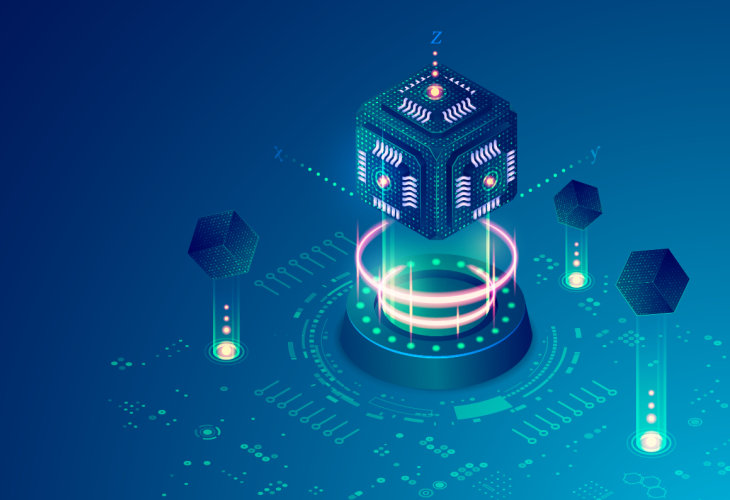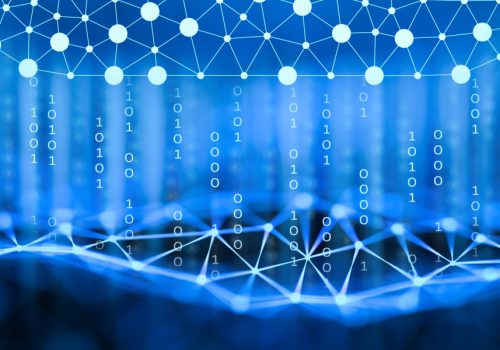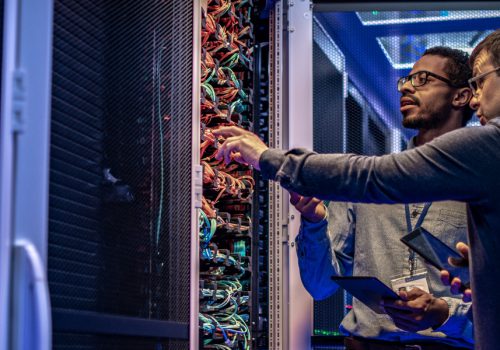Quantum computing is an emerging technology that has the potential to impact multiple industries relying on intensive computational tasks. At its core, it is an interdisciplinary field combining computing science, statistics, and physics with the peculiar phenomena of quantum mechanics. The same can also be said of quantum hardware itself – building quantum computers relies on many different types of engineering, e.g., optics, cryogenics, microwaves, and many more.
Quantum computing holds the promise of tackling certain tasks much more efficiently than classical computers can, or solving problems that are classically intractable. The point at which a quantum computer can perform a specific task more efficiently than the best classical computer is usually referred to as quantum advantage. The potential to massively speed up machine learning or optimization problems, carry out complex and resourcedemanding simulations, or the implications and impact of quantum computing to cybersecurity through the ability to efficiently factor large numbers – these are some examples that highlight quantum computing’s applicability. It is evident, therefore, that beyond the theoretical reverie lies a realm of tangible applications that could reshape sectors and fields such as finance, cybersecurity, drug discovery, logistics, and more.
Delving into the realm of quantum computing
Quantum computing leverages the principles of quantum mechanics to process and manipulate information in ways that are fundamentally different to conventional computers. While classical computers use bits as the fundamental unit of information, which can be either 0 or 1, quantum computers use quantum bits, or qubits, which can represent a 0, a 1, or both states simultaneously. Qubits also exhibit a second fundamental principle of quantum mechanics: the ability to become entangled, i.e., qubits can become correlated in a way that renders their individual states indistinguishable.
Such quantum mechanical principles are the source of the immense computational potential of quantum computing.
Quantum advantage, as mentioned above, constitutes the realization of that potential and can come in various forms:
- A quantum computer exhibits computational speedup, i.e., performs a task faster than it is possible classically or is able to solve classically infeasible problems.
- Using a quantum computer, we get a solution that is of better quality than the best classical one.
- Using a quantum computer is more energy-efficient or cost-efficient, i.e., it requires significantly less energy or is much less costly than using classical supercomputers.
Quantum applications and quantum advantage
In essence, quantum algorithms and their promise to solve complex problems, provide an advantage over what we understand as classically possible, form the backbone of the interest and expansion the field has witnessed over recent years. Using quantum algorithms, quantum applications define implementable solutions to complex problems that allow us to harness the potential of quantum computers, making quantum computing increasingly relevant. In other words, quantum applications translate the theoretical algorithmic advantage to real-world impact by solving a meaningful problem.
Many businesses and organizations have shown clear interest in quantum applications. Some focus on specific ones (e.g., pharmaceutical companies working with modelling and simulations, optimization applications in the healthcare sector, etc.), while others explore the whole spectrum of quantum applications (e.g., the finance sector focusing on potential quantum applications in modelling, optimization, machine learning, and cybersecurity).
What applications and when?
More and more organizations and research institutions embark on the quest for identifying quantum applications and realizing potential quantum advantages. This interest shows that many realize the importance of this nascent technology and its applications – the potential to solve difficult or intractable problems, impact economies and societies, and change the ability and speed at which we innovate as a species. It is, then, not entirely unexpected that a critical question comes up:
What are the potential applications of quantum computing and when will we realize a quantum advantage?
Researchers and organizations continuously find problems relevant to their research or business models that may benefit from, or be impacted by quantum computing. Generally, we can see common trends in the types of quantum applications that are explored and they can be grouped by the type of problem they tackle. Therefore, we can categorise quantum applications into four domains considering their corresponding problem types: simulation, optimization, machine learning, and cybersecurity.
1. Simulation
Simulations are one of the most promising application domains for quantum computing. Quantum systems are notoriously complex to simulate classically, even for the most advanced supercomputers. Quantum computers offer a unique vantage point, allowing scientists to accurately model quantum interactions, molecular structures, and chemical reactions. This could revolutionize drug discovery, material science, and even provide insights into fundamental physics that have eluded us thus far.
Quantum simulations have the potential to revolutionize various scientific and technological fields:
- Materials science: Quantum systems often involve many interacting particles, making their behavior challenging to simulate classically. Quantum computers could simulate the electronic structure of molecules and materials, enabling the discovery of new materials with specific properties for applications in areas such as drug discovery, energy storage, and catalyst design.
- Chemistry: Quantum simulations can provide insights into chemical reactions, reaction mechanisms, and molecular properties that are difficult to obtain through classical methods. This may lead to the development of more efficient and accurate methods for drug design, chemical processes, and material synthesis.
- Condensed matter physics: Quantum systems with many interacting particles can give rise to exotic phenomena, such as superconductivity and quantum phase transitions. Quantum simulators could help researchers explore and understand these phenomena, potentially leading to the development of new materials with unique properties.
- High-energy physics: Simulating the behavior of particles in high-energy physics experiments, such as those conducted at particle accelerators, can be extremely computationally intensive. Quantum computers could assist in simulating and understanding the fundamental particles and interactions involved.
- Quantum field theory: Quantum simulations can aid in studying the behavior of quantum fields, which are fundamental in particle physics. This could lead to insights into phenomena like particle creation and annihilation, and the interactions between fields.
- Finance: Quantum computing’s ability to efficiently model very complex scenarios can find applications in massive computational tasks such as risk assessment, option pricing, or various predictions in the financial industry.
- Climate modeling: Quantum simulations could enhance climate modeling by simulating quantum systems involved in chemical and physical processes relevant to climate change, leading to more accurate predictions.
- Molecular biology: Quantum simulations could help understand complex biomolecular systems, such as protein folding, which is critical for drug discovery and understanding biological processes.

2. Optimization
Quantum optimization is another compelling application domain for quantum computing. Optimization problems are prevalent in various fields where finding the best solution from a vast set of possibilities is crucial. Classically, these can be laborious computations, but quantum computing introduces optimization algorithms that have the potential to accelerate such tasks. Solving optimization problems lies at the heart of many industry sectors.
- Logistics and supply chain management: Optimizing routes, schedules, and resource allocations in logistics and supply chain management can be extremely complex. Quantum optimization algorithms could help find optimal solutions more quickly, leading to cost savings and improved efficiency.
- Portfolio optimization: In finance, quantum optimization has the potential to be used to optimize investment portfolios by considering multiple assets, risk factors, and constraints. This could lead to better investment strategies and risk management.
- Energy and resource management: Quantum optimization could be applied to problems related to energy distribution, resource allocation, and grid management. This includes optimizing power distribution, minimizing energy consumption, and improving the efficiency of renewable energy sources.
- Manufacturing and process optimization: Optimizing manufacturing processes, production schedules, and resource utilization in industries could be enhanced with quantum optimization. This may lead to reduced waste, increased productivity, and improved quality control.
- Machine learning and AI: Many machine learning and artificial intelligence tasks involve optimization problems, such as parameter tuning, clustering, and feature selection. Quantum optimization could accelerate these processes and lead to more effective AI models.
- Telecommunications: Quantum optimization could be used for tasks such as optimizing network routing, allocating resources in communication networks, and improving wireless signal coverage.
- Chemical and drug discovery: Optimizing molecular structures for drug discovery involves searching for configurations that result in desired properties. Quantum optimization algorithms could enhance this process by efficiently exploring the vast space of possible configurations.
- Traffic flow and urban planning: Optimizing traffic flow, public transportation routes and urban planning may benefit from quantum optimization techniques. This could lead to reduced congestion, shorter travel times, and more efficient city designs.
- Aerospace and engineering: Designing complex engineering systems, such as aircraft or spacecraft, often involves optimizing multiple parameters for performance and safety. Quantum optimization could aid in finding optimal designs more quickly.
- Combinatorial optimization: Many combinatorial optimization problems, such as the Traveling Salesman Problem or graph colouring, become exponentially harder to solve as the problem size increases. Quantum optimization algorithms might provide speedups for solving these types of problems.
3. Machine learning
Quantum machine learning can harness the power of quantum computing to expedite certain machine learning tasks, unlocking advancements in fields ranging from pattern recognition to optimization problems. Here are some ways quantum machine learning can be applied:
- Quantum data processing: Quantum computers can potentially process large amounts of data more efficiently due to their inherent parallelism. Quantum data processing techniques could accelerate tasks like data cleaning, dimensionality reduction, and pre-processing.
- Quantum data analysis: Quantum algorithms could enhance data analysis tasks like clustering, classification, and anomaly detection. Quantum computers might find patterns and structures in data more quickly than their classical counterparts.
- Quantum feature selection: Quantum computers might aid in selecting relevant features for machine learning tasks. This could lead to more efficient and accurate models, especially in high-dimensional data.
- Quantum neural networks: Quantum versions of neural networks, known as quantum neural networks, have been proposed.
These networks could theoretically perform certain types of computations, such as optimization tasks or solving linear equations, faster than classical neural networks. - Quantum generative models: Quantum computers might help in generating complex data distributions efficiently, which is useful for tasks like generating realistic samples for simulations or creating novel designs.
- Quantum support vector machines: Quantum computers could potentially speed up training and inference tasks for support vector machines, a widely used classification algorithm.
- Quantum reinforcement learning: Quantum systems could be used to speed up certain aspects of reinforcement learning, which involves training agents to make decisions in dynamic environments.
- Quantum Boltzmann machines: Quantum versions of Boltzmann machines might be used for tasks like optimization, sampling, and probabilistic modeling.
- Quantum Kernel methods: Quantum computers could potentially accelerate kernel methods used in machine learning for tasks like support vector machines and kernel regression.
4. Cryptography
Quantum computing has the potential to significantly impact cybersecurity by both enhancing cryptographic security and posing new challenges. On one hand, Shor’s algorithm bears the potential to affect widely used encryption methods. On the other hand, quantum cryptography offers the promise of encryption through a combination of post-quantum cryptography and quantum key distribution, allowing for more secure communications channels. As a result, the cybersecurity landscape is undergoing a transformation, where organizations aim to adapt by preparing for both the threats and opportunities presented by quantum computing.
Generally, quantum-resistant encryption techniques based on mathematical complexity are usually referred to as post-quantum cryptography (PQC). Within the literature, there is a distinguishing framing between such approaches based on mathematical complexity and others that inherently rely on quantum mechanics. Some key aspects and applications of quantum cryptography appear below:
- Quantum Key Distribution (QKD): The primary application of quantum cryptography is to establish secure encryption keys between two parties, often referred to as Alice and Bob. QKD protocols, like the famous BB84 protocol, utilize quantum properties such as the no-cloning theorem and quantum measurement to ensure that any attempt to eavesdrop on the communication would be detectable, alerting the parties to potential security breaches.
- Quantum Key Exchange: QKD protocols enable Alice and Bob to exchange cryptographic keys securely over an insecure channel. These keys can then be used for subsequent classical encryption methods, such as symmetric-key cryptography, ensuring that the communication remains confidential.
- Quantum secure authentication: Quantum cryptography can also be used for secure authentication, ensuring that a message comes from a legitimate sender and has not been tampered with during transmission.
- Quantum network security: Quantum cryptography can be applied to secure communication in quantum networks, which involve the distribution of quantum states between multiple parties. These networks are envisioned for tasks like quantum computing, distributed quantum sensing, and secure communication over long distances.
- Quantum key management: Quantum key distribution can be integrated with classical cryptographic protocols to manage encryption keys securely, providing a comprehensive approach to data protection.
- Quantum cryptanalysis and security analysis: Quantum techniques can also be used to analyze the security of classical cryptographic protocols. Quantum computers could potentially be used to attack classical cryptographic systems, which has implications for the future of secure communication.
- Practical implementations: Quantum cryptography has been demonstrated in various real-world scenarios, such as point-to-point communication, satellite-based quantum communication, and fiber-optic networks. Commercial QKD systems are available, although they are typically limited to specialized applications due to current technological challenges.
As we tread this path, it’s vital to acknowledge the thorns amidst the roses. Quantum computers will not be able to solve every problem and will not be suitable for everyone and everything. As seen above, they excel in specific applications but also remain outpaced by classical counterparts in others.

Challenges
Even though the field has gone through great progress in recent years, quantum computing is still in its very early stages of development. Some real challenges remain to overcome. Currently, we are traversing the era dubbed as Noisy Intermediate-Scale Quantum (NISQ) era. The “noisy” part hints at one of the main challenges – the fact that quantum computers are susceptible to various forms of errors. For example, operations that define programs running on a quantum computer can be erroneous, qubits struggle to hold information, which tends to become corrupted as time passes, errors caused by thermal interactions with the environment, and so on.
Another big challenge for the field is scalability, with implications that can be twofold. Firstly, scaling devices can be difficult in terms of hardware characteristics, such as space within quantum processors. The second implication goes hand-in-hand with the noise – scaling up the number of qubits usually also amplifies the noise, making it increasingly difficult to reliably scale computations.
There are also further caveats, such as the explainability of quantum computing models and algorithms.
Due to the fundamentally different way that quantum computing works, it is often quite difficult for individuals lacking certain skills to understand and use the models.
These challenges very much affect the applications that we can run at this stage, as well as our predictions of when we can run applications that provide a quantum advantage.
Answering the when
Having an overview of “what applications” gives an insight into the potential of quantum computing. Now for the second part of the critical question and the more challenging to answer – “When” can we run these applications?
Our ability to implement and run quantum applications that solve meaningful problems is very much anchored in the maturity of the technology itself. The number of qubits that are housed within quantum processors, their quality and ability to hold information, and our ability to control that information, correct errors and battle the noise – all describe fundamental enabling factors that affect what applications we can implement. Therefore, to answer the “when”, it is essential to be able to understand the enablers and track their evolution.
Importantly, as enabling technologies mature, and with them the capabilities of the quantum devices themselves, we will be able to implement and run bigger and better applications and address larger and more complex problems. As we traverse from the NISQ era to a future era where quantum computers are becoming fault-tolerant, we will see an expansion of what we currently think is possible. This very promise is what fuels research and development in the field, making it one of the most exciting emerging technologies.
In the meantime, there is a crucial role to be played by emulation – i.e., using classical computers to replicate the way quantum computers behave and operate. This is a really powerful tool, and especially relevant to the NISQ era, that allows us to grasp what really goes on during the runtime of a quantum computer, understand capabilities by running algorithms in an error-free scenario, or recreate and better understand the noise and errors that occur during a computation.
Benchmarking, verification, and standards
Considering the current state-of-the-art, it is essential to understand the capabilities and the performance of current hardware and software to efficiently develop and implement algorithms and applications.
This can be achieved by the process of benchmarking. Benchmarking produces metrics that indicate the performance of a quantum computer, and knowledge about how a system works and allows us to evaluate hardware, software, and algorithms.
A big part of assuring the current and future capabilities of quantum computing systems comes from developing processes and techniques to verify their performance. There are two main points here: the verification of hardware capabilities, and the verification of algorithm performance and quantum advantage. On the former, we focus on checking that all the elements that constitute a quantum computer work the way they are intended to.
On the latter, we want to think about processes that verify that an algorithm or application truly exhibits quantum advantage. In the end, there is great value in standardizing verification and centralizing this process through an influential and trusted authority.
The above discussion reveals a crucial gap in the current landscape: standards for quantum computing. There is a great need to develop recognized and standardized metrics and processes, not only for benchmarking and verification but for several aspects associated with the development and utilization of quantum computing. This would allow us to know what are the crucial functionalities and indicators that we need to strive for when developing hardware, software, and applications. Currently, there are several initiatives from well-recognized institutions such as IEEE and BSI that work to that end.
Summary
Thinking back on the problem domains of simulation, optimization, machine learning, and cybersecurity, we find a large number of problems that have the potential to be solved using quantum computing. Equally, there is a lot of uncertainty (owing to the current stage of the field) that affects our current understanding of what can be solved, how, with what benefit, and (most crucially) when. Nevertheless, the potential of quantum computing fuels research and development from industry and academia.
It is important to understand that, quantum computing is still in the very early stages of development. For that reason, within the scientific community, there is a drive to understand the capabilities, address the errors (also known as noise) that early-stage quantum processors exhibit, and overcome barriers in their scalability. Similarly, activities such as benchmarking and verification are fundamental enabling steps for the growth and maturity of the field.
Such activities can also contribute towards the development of standards, a crucial step towards understanding what specific capabilities or quality metrics we need to strive for to progress the field towards practical quantum advantage and harness the potential that quantum computing has to offer.
Finally, the development and implementation of quantum applications are very much anchored in the maturity of the technology and its enablers. Even though quantum computing is still in its early stages of development, it is important to acknowledge its extraordinary growth and acceleration, with many of the large IT companies engaging with their own R&D programmes and service offerings, alongside a vibrant emerging industry of startup and scale-up companies.
As the technology matures and the performance and capabilities improve, then we can expect the application space to really open up.









